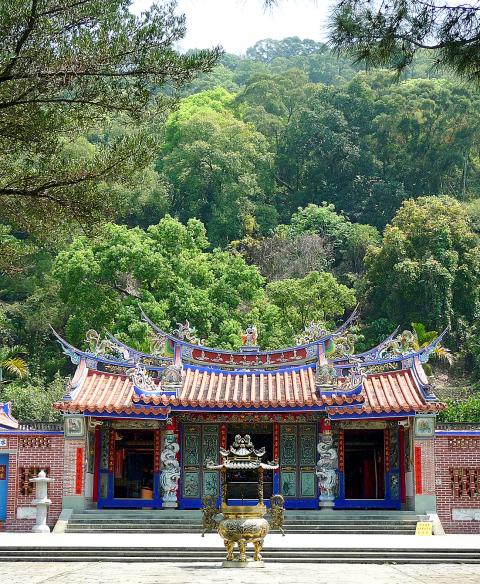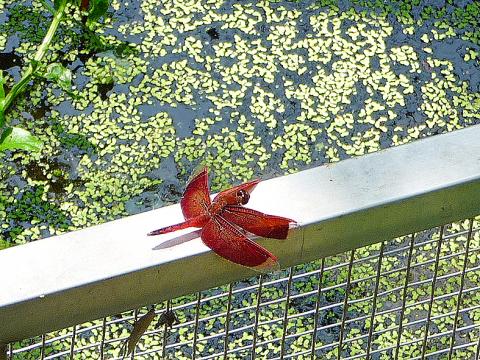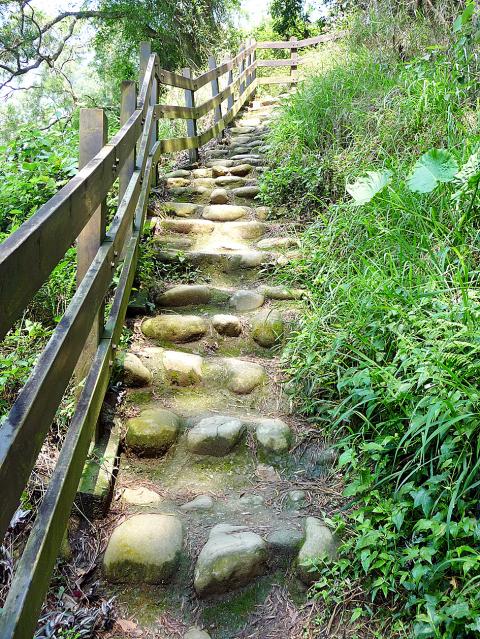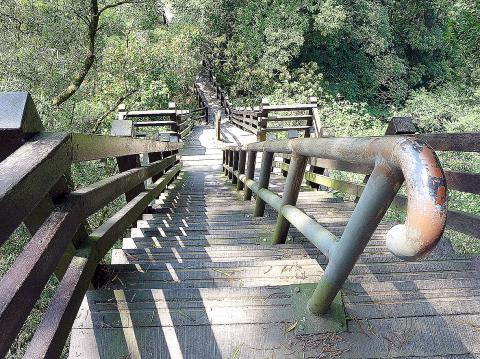In my younger days, I often joined multi-day treks deep into Taiwan’s highlands. For the past decade, however, family and work responsibilities have kept me close to home. My attention has therefore shifted to the foothills — and one of the finest low-altitude trails I’ve tramped along recently is in Changhua, a county few people associate with hiking.
Cingshueiyan Forest Recreation Area (清水岩森林遊樂區) in Shetou Township (社頭鄉) covers part of the western slope of the ridge that runs between Baguashan (八卦山) in Changhua City and Ershuei (二水) in the southern part of the county. The recreation area takes its name from Cingshueiyan Temple (清水岩寺), a Buddhist shrine established in 1728. In terms of size and activity, this place of worship isn’t remarkable. But thanks to its lovely setting, it’s an attraction in its own right.
Cingshuei means “freshwater” or “clear water,” and a spring bubbles to the surface here, watched over by a little statue of Guanyin. The spring-water is said to be potable, and some people use the bamboo ladles to take sips, but I refilled my canteen from the drinking-water machine inside the shrine. Much later, when I reached the top of the ridge and saw how intensively it’s farmed, I was glad I’d done that.

Photo: Steven Crook
It takes less than 10 minutes to stroll from the temple to the trail head, at 131m above sea level, of what most of the signs label the 18-Turns Trail (十八彎森林步道). A mapboard by the entrance uses an alternative name (Eighteen Turns Historical Trail, 十八彎古道) and explains that, long before the Japanese colonial period, merchants from Lukang (鹿港) and their porters used it to carry salt and other commodities inland.
The first third of the trail follows a waterway that was devastated by a typhoon in the summer of 2008. Since then, the Forestry Bureau has applied eco-friendly engineering principles to its restoration. Rather than pour concrete, the bureau has stabilized the banks using locally-sourced stones and wood. Barriers made of round stones are porous, like natural riverbanks. Before eventually rotting away, planks of wood hold soil in place long enough for trees and plants to grow the roots that are an essential element of stable slopelands.
When I visited, less than a fortnight ago, the riverbed was bone dry and carpeted with Spanish needle (Bidens pilosa). Academics have dubbed this daisy-like flower a threat to native species and one of the twenty most noxious invasive plants in Taiwan. That said, butterflies seem to adore it. Less common, but more colorful, were the mauve flowers of the billygoat-weed (Ageratum conyzoides, another invasive).

Photo: Steven Crook
The trail, which is 920m long, gets steeper as you approach the ridge. Because of the emphasis on natural materials, there are stretches where you’re walking on smooth stones which look as though they were taken from a riverbed. After rain, I thought to myself, this could get very slippery. On the plus side, most of the pathway is shaded.
None of the trees here are real monsters. This is because the authorities didn’t begin managing this area until the late 1950s, and for many years the emphasis was, according to Chinese-language sources, “on tree species that generated economic benefits.” In other words, trees were felled as soon as they reached a useful size. In recent decades, the function of Taiwan’s state-owned forests has shifted from meeting the needs of industry to conserving soil, water, and biodiversity.
As soon as I reached the ridge, I was struck by the difference in topography. The western side is a cliff-like. The eastern side very gradually slopes down toward Mingjian (名間) in Nantou County. Tea and pineapples are grown on this plateau.

Photo: Steven Crook
To continue my hike, I walked south on a flat, sealed track for almost 300m to the eastern entrance for the Central Peak Trails (中央嶺森林步道). There, 337m above sea level, I hesitated for a few minutes, and not simply because the view over the lowlands was quite impressive. The stairs down into the forest are among the steepest I’ve come across. None of the photos I took do proper justice to the precipitous incline.
Depending on how much of a workout you want, and whether you mind tramping back to Cingshueiyan Temple via a longish stretch of tarmac, you can follow well-maintained paths to the first, second, third, and/or fifth peaks — the mapboards I saw didn’t mention a fourth peak. I took a shorter route which involved about 1.5km of walking.
My circuit completed after three enjoyable hours, I returned to the temple to get more water. Inside, I was distracted by a moth. Its wingspan wasn’t remarkable, but in terms of body length and thickness, it was one of the largest I’ve ever seen.

Photo: Steven Crook
The moth used its proboscis to sip nectar from the flowers on the altars. It hovered close to the red electric candles before moving on to a Buddha statuette. The icon’s yellowish shade of gold must have fooled the lepidopteran into thinking it might be a nectar-producing plant. The flying visitor probed Buddha’s ear, then — before I’d even had time to smile — it fluttered off in the direction of the forest.

Photo: Steven Crook

On April 26, The Lancet published a letter from two doctors at Taichung-based China Medical University Hospital (CMUH) warning that “Taiwan’s Health Care System is on the Brink of Collapse.” The authors said that “Years of policy inaction and mismanagement of resources have led to the National Health Insurance system operating under unsustainable conditions.” The pushback was immediate. Errors in the paper were quickly identified and publicized, to discredit the authors (the hospital apologized). CNA reported that CMUH said the letter described Taiwan in 2021 as having 62 nurses per 10,000 people, when the correct number was 78 nurses per 10,000

As we live longer, our risk of cognitive impairment is increasing. How can we delay the onset of symptoms? Do we have to give up every indulgence or can small changes make a difference? We asked neurologists for tips on how to keep our brains healthy for life. TAKE CARE OF YOUR HEALTH “All of the sensible things that apply to bodily health apply to brain health,” says Suzanne O’Sullivan, a consultant in neurology at the National Hospital for Neurology and Neurosurgery in London, and the author of The Age of Diagnosis. “When you’re 20, you can get away with absolute

May 5 to May 11 What started out as friction between Taiwanese students at Taichung First High School and a Japanese head cook escalated dramatically over the first two weeks of May 1927. It began on April 30 when the cook’s wife knew that lotus starch used in that night’s dinner had rat feces in it, but failed to inform staff until the meal was already prepared. The students believed that her silence was intentional, and filed a complaint. The school’s Japanese administrators sided with the cook’s family, dismissing the students as troublemakers and clamping down on their freedoms — with

As Donald Trump’s executive order in March led to the shuttering of Voice of America (VOA) — the global broadcaster whose roots date back to the fight against Nazi propaganda — he quickly attracted support from figures not used to aligning themselves with any US administration. Trump had ordered the US Agency for Global Media, the federal agency that funds VOA and other groups promoting independent journalism overseas, to be “eliminated to the maximum extent consistent with applicable law.” The decision suddenly halted programming in 49 languages to more than 425 million people. In Moscow, Margarita Simonyan, the hardline editor-in-chief of the